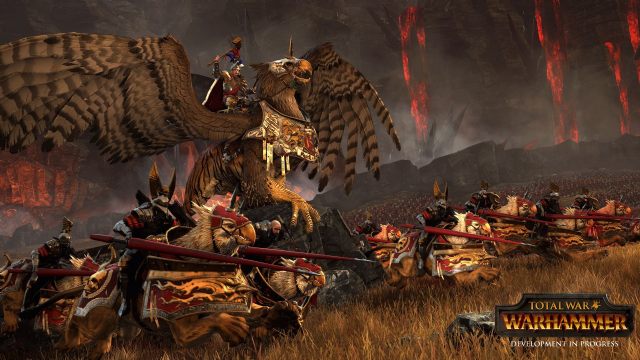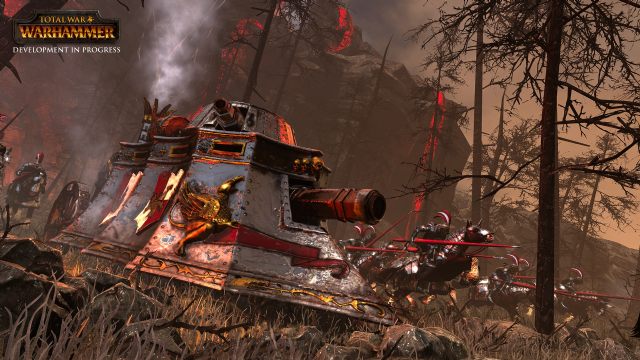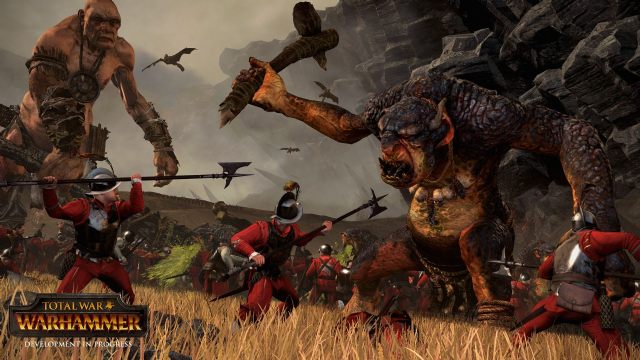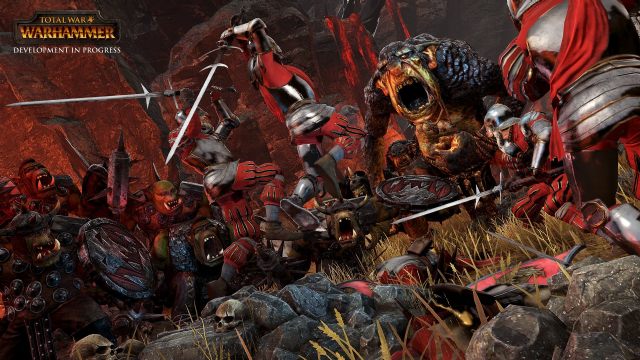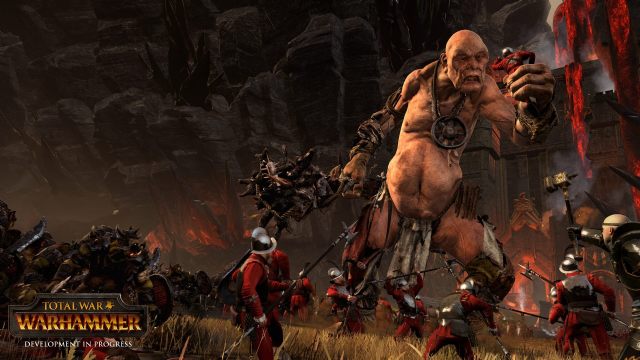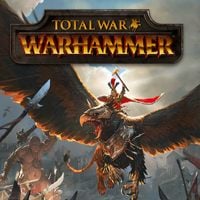Total War: Warhammer – A New Kind of Epicness Introduced to the Flagship Series from Creative Assembly
Lovers of dungeons and dragons have been waiting a long time for this combo – spectacular battles set in a fantasy world fought on an impressive scale characteristic of the Total War series.
TOTAL WAR: WARHAMMER IN A NUTSHELL:
- The tenth edition in the classic strategy series Total War (developed by Creative Assembly), while also being the first set in a non-historical world;
- Game set in the dark world of Warhammer Fantasy (created by Games Workshop);
- A variety of factions (so far confirmed are people, orcs, the undead, and dwarves) characterized by a very large diversity of styles of play;
- A sandbox campaign with optional task sequences for the heroes, which represent the historical events from the Warhammer universe;
- The most epic battles so far in the history of the series, featuring extremely diverse types of armies, wizards, flying units, etc.
British studio Creative Assembly decided to honor the fifteenth anniversary of its flagship franchise – the strategic series Total War – in a rather unusual way. Namely, the jubilee was accompanied by an announcement of a game that many orthodox lovers of Total War might deem blasphemous. As for the rest of the public, Total War: Warhammer managed to capture the imagination of gamers like no other strategy in recent years. Sure, history is fun and worth promoting in video games, but when looking at the scale of battles in Rome II, many of us dream about the same grandeur accompanying clashes involving dragons, demons, elves, and orcs. Although the industry has known similar cases – like the RTS Warhammer: Mark of Chaos – they are yesterday's news. Recently, strategies featuring real-time battles have been dominated by historical periods and science-fiction, so it's no surprise that news of a transfer of a well-known series into the world of sword and magic proved so sensational. We decided to gather all the materials about the latest installment in the Total War series that Creative Assembly recently shared with the media from around the world (and in particular with the editors from PC Gamer, who visited the headquarters of the studio). On the basis of what has been disclosed so far, we can go so far as to say that the British developer is on its way to secure the grace and blessing of Sigmar until the end of time.
"Bleak world full of dangerous adventures"
For starters, let's introduce the world of Warhammer Fantasy to those who have no experience whatsoever with it. It would be easiest to compare it with the sixteenth-century Europe as seen through a distorting mirror – at least with regard to the Old World, which is the central part of the continent, and also where the story takes place. Although it is only one of the many realms here – we also have the counterparts of Asia, Africa and the Americas – it provides the main arena of events and is therefore closer to its real-world counterpart than the rest of the lands available. The focal point is the Empire – an equivalent of sorts of the German-speaking Habsburg empire during its heyday. It’s therefore a powerful human state divided into provinces, and ruled by a revered Emperor. However, it suffers from numerous problems, both of internal and – above all – external nature. Since the discussed world is a fantasy universe, threats rarely take the form of neighboring countries setting their sights on the imperial estate. Usually, the enemies are simply inhabitants of the most powerful country of the Old World, thirsty for human blood. What other than that could be more appealing to the demons of Chaos, orcs and the undead?
According to those who’ve seen it, Total War: Warhammer is simply spectacular in action. Of course, it's difficult to verify this opinion without being able to watch the presentation itself, but the handful of pictures available so far is enough not to be surprised by the enthusiastic assessments. Journalists are especially impressed by the animation of units (much more polished than ever before in the series) and the enormous diversity of individual units as well as attention to detail in their creation. Still, let's bear in mind that the material shown at the developer’s headquarters was a carefully directed spectacle – the battles taking place on the screens of our monitors are not likely to be equally monumental every time.
So far, four playable factions have been revealed in Total War: Warhammer. At the forefront is of course the aforementioned Empire – well-armored human troops supported by a cavalry on flying griffins. In alliance with them are the dwarfs, constituting another heavily armored army, with an advanced technology based on the use of black powder and steam at its disposal. Pitted against them are mainly orcs – not a very intelligent horde, but when its rage is channeled properly, it can wreak terrible havoc. In turn, much more subtle, but no less effective in confronting the Empire's forces is the army of the undead, led by the powerful vampire aristocracy of Sylvania. It is highly likely that these will be the four basic fractions available in the core version of the game, but additional parties to the conflict might be disclosed at a later stage. This possibility seems to be confirmed by thinly veiled suggestions thrown by the developers in the direction of journalists, and by reminding that Warhammer Fantasy just couldn’t do without the demonic representatives of Chaos.
Still, there might be more. The discussed universe features many factions that have a chance to be included in the game. This number cannot compare to the nations of the ancient world, present in the two previous installments of the Total War series, but in terms of variety it definitely gets better. This is due to the fact that we are dealing with groups as diverse as Wood Elves inhabiting the forests that cover a large expanse of the Old World, the Knights Errant of Brittany, soldiers fighting on behalf of rival city-states of Tilea, "Cossacks" of the quasi-Slavic Kislev, marine raiders from the cold Norska, monstrous beastmen, Skaven (rat people) looming in the darkness, or even Dark Elves and Lizardmen from the counterparts of Americas, the inhabitants of distant lands reminiscent of Arabia and Cathay, or High Elves from the magical island of Ulthuan. As you can see, the possibilities abound, although it is likely that some of these groups won't make it to the game (if only because of their origin from outside the Old World), or will be incorporated into larger factions. And let's not forget that Creative Assembly will certainly save some attractions – both with regard to parties, as well as arenas of events – for DLC expansions.
"To me, sons of Sigmar! For the Empire!"
The demo that was shown to journalists only contained the battle of Black Fire Pass (situated on the southern edge of the Empire), waged between human forces led by Emperor Karl Franz and the Greenskins given orders by black orc Grimgore Ironhide. A wonderful spectacle played out on the screen in which countless types of units were engaged. Different varieties of infantry took on each other in a conventional fashion while far less common creatures, such as goblin wolf riders, orc cavalry riding wild pigs, giants, or arachnorok spiders wrought havoc nearby. There was no shortage of artillery or siege engines (e.g. catapults launching goblins), standing out in a crowd of warriors; numerous as well were the magicians, causing substantial chaos on the battlefield by casting powerful spells. Complementing this is a totally new feature in the Total War series, namely flying units, represented during the show mainly by imperial griffins and wyverns fighting on the side of the Greenskins. These winged creatures circled around each other and jumped at each others' throats, and then lowered their flight to wreak havoc among land forces.
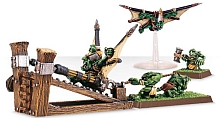
Let’s take a moment to discuss the catapult launching goblins (Doom Divers Catapult), as we are dealing with a unit that we will be able to control directly. When launching a living missile into the air, nothing stops us from switching to goblin POV and direct his flight the same way we would do in an arcade aircraft shooter. Unfortunately, we don't know yet whether it's just a fun feature, or Total War: Warhammer will offer more attractions of this kind.
Of key importance is the diversity of troops. As one of the developers told PC Gamer, "there will be more differences in the ranks of each race in Total War: Warhammer than among all factions in any of the previous installments in the series." It only takes one look at the miniature units available in the Warhammer tabletop battle game to believe that these are not empty promises – the universe created by Games Workshop is really extremely rich in this respect. It's also worth going back to another, already mentioned new feature, namely magic. Magical units will prove to be expensive and vulnerable to attacks, but their abilities will often be able to turn the tide of a battle – provided that the battlefield will allow it. This is due to the fact that in the Warhammer universe power is in fact dependent on the flow of magical winds, which ate unseen to us, and they don’t have the same intensity in each place. This means that our mages will have a variable potential, depending on the place in which we face the enemy.
"But a knife thrust from anarchy in the Empire"
Creative Assembly hasn't revealed its strategic map yet – the main view which we use to control all of our numerous resources – but that doesn't mean that the developer is not willing to discuss this subject. As I mentioned at the beginning, the arena of the events will be the main continent of the Warhammer Fantasy world, i.e. the Old World – though it is not yet known whether this means only the area of the Empire and its adjacent regions, or the more distant corners of the land such as Tilea, Estalia or Norska as well. What’s important, the strategic map will be somewhat detached from the passage of time – the story will not take place in any particular historical period (although the presence of Karl Franz indicates the situation from recent textbooks for the tabletop version of Warhammer), and what's more, our progress in the game will not be accompanied by the succession of seasons. We will also make use of complex diplomatic options, but this simply stems from the specificity of the Old World – it's a universe where war actually never stops, so while we can accomplish a temporary ceasefire, we shouldn't count on a lasting peace between the Empire and the orcs.
We’ll also notice a great variety of factions when managing the country. Although so far we could only see it exemplified by the human state and Greenskins, it already looks very promising. Playing on the part of Emperor Karl Franz will bear the most resemblance to what we’ve been used to in the previous installments of the Total War series – we will expand the city, develop technology, recruit troops in the classic way, etc. Playing as Orcs will offer a completely different concept of gameplay. The expansion will become a secondary objective, while the most important will be the so-called "Waaagh!". This peculiar word, known mainly as a kind of battle cry, encompasses the original spirit of the Greenskin race, used in the game as a resource of sort. The more often we throw ourselves into battle and emerge victorious, the greater will be the recognition of our leader among his kind, and the more troops will be brought together under his banner. But if we stall too long or lose battles, our troops will fight among themselves, which will lead the army to disintegrate, or just abandon us.
As in the previous Total Wars, the co-called “agents” will play an important role on the strategic map. These are special, independently moving characters that have unique abilities. So far, wizards, lords and generals have been revealed. Each faction is to have three or four such classes of heroes. Their application will vary depending on the party, and they will have fairly extensive skill trees, allowing them to develop in different directions. What's more, an agent residing in an area that has just become a battleground will take part in the battle as a separate entity with specific properties. It is mainly in such a way that we will get mages, who may tip the scales of victory to our side. Lords will also prove useful in battle, as their primary role will be to command troops. Generals are invaluable as well, being exceptional leaders – we will get one or two per faction. This is the rank represented by characters such as Karl Franz and Grimgore Ironhide. In addition, they are immortal, unlike the rest of the characters. If they fall in battle, they will simply become inactive for a few turns spent on recovery.
Although the campaign will have an open structure and, as mentioned above, will not be set in any particular historical period, the gameplay in Total War: Warhammer will not be devoid of any plot. The creators give the player a number of optional tasks (often merging into sequences) associated with different events from the history of the Old World. Their execution would bring tangible benefits, such as powerful items and mounts for heroes. The battle of Black Fire Pass, which the journalists had the opportunity to witness, represents such a series of missions – this is the final link in the chain of quests leading to acquiring for Karl Franz the legendary rune hammer called Ghal Maraz (which is the symbol of the Empire, used by Sigmar in battles that led to the creation of this state thousands of years ago). Creative Assembly is still keeping the details of other planned events under wraps, but the world of Warhammer has a very rich history, so you can expect a large diversity of tasks.
Game for a god of games!
To sum up, many things suggest that in 2016 a huge bomb will go off in the strategy game genre. Of course, it is still too early to predict great success – after all, Total War: Warhammer hasn't even been presented in a truly playable form – but there are already enough reasons both for enthusiasts of strategy and maniacs of tabletop Warhammer Fantasy Battle to drool in anticipation. First of all, the project is supervised by Creative Assembly, a team that had over 15 years to refine the perfect formula for the Total War series, so botching it is simply out of the question (although it should be noted that certain elements, like artificial intelligence, are out of their grasp for some reason). Second, everything that has already been said and shown goes to demonstrate that the developer treats this new reality with due respect, and this should result in a convincing rendering of the dark atmosphere of the Old World. Let's add to this the visualization of battles at a graphical level so far unheard of in the strategy genre, and we have a smash hit. Unless the British overdo their programming magic and their project falls victim to some sort of mutation from Chaos...
